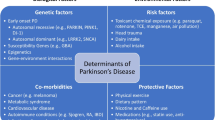Abstract
Hypersomnia is a rare neurologic disorder characterized by an excessive daytime sleepiness with long naps, despite an undisturbed nocturnal sleep. The impaired daytime alertness and sleep inertia are different from general fatigue. This disorder is often classified as idiopathic. Here, we report the case of a young patient presenting both a mitochondrial disease and a hypersomnia. We discuss the links between the two pathologies and propose to systematically investigate personal and familial mitochondrial features in case of hypersomnia, to offer suitable genetic tests. Conversely, fatigue could be one of the complaints reported by patients with a confirmed mitochondrial disease, which is multifactorial. Sleep quality and somnolence should be examined in these patients as specific treatments exist for this debilitating disorder.


Similar content being viewed by others
References
American Academy of Sleep Medicine. International classification of sleep disorders. 2014
Rye DB, Donald L, Bliwise DL, Kathy Parker K, et al. Modulation of vigilance in the primary hypersomnias by endogenous enhancement of GABAA receptors. Sci Transl Med. 2012;4:161ra151.
Dauvilliers Y, Evangelista E, Lopez R, Barateau L, Jaussent I, Cens T, et al. Absence of γ-aminobutyric acid-a receptor potentiation in central hypersomnolence disorders. Ann Neurol. 2016;80:259–68.
Ali M, Auger RR, Slocumb NL, Morgenthaler TI. Idiopathic hypersomnia: clinical features and response to treatment. J Clin Sleep Med. 2009;5:562–8.
Anderson KN, Pilsworth S, Sharples LD, Smith IE, Shneerson JM. Idiopathic hypersomnia: a study of 77 cases. Sleep. 2007;30:1274–81.
Vernet C, Arnulf I. Idiopathic hypersomnia with and without long sleep time: a controlled series of 75 patients. Sleep. 2009;32:753–9.
Miyagawa T, Toyoda H, Kanbayashi T et al. (2015) An association analysis of HLA-DQB1 with narcolepsy without cataplexy and idiopathic hypersomnia with/without long sleep time in a Japanese population. Hum Genome Var 2:15031
Trotti LM, Bliwise DL. Brain MRI findings in patients with idiopathic hypersomnia. Clin Neurol Neurosurg. 2017;157:19–21.
Sakaue S, Ohmuro J, Mishina T, et al. A case of diabetes, deafness, cardiomyopathy, and central sleep apnea: novel mitochondrial DNA polymorphisms. Tohoku J Exp Med. 2002;196:203–11.
Ramezani RJ, Stacpoole PW. Sleep disorders associated with primary mitochondrial diseases. J Clin Sleep Med. 2014;10:1233–9.
McKinney M, Jacksonville MC. Brain cholinergic vulnerability: relevance to behavior and disease. Biochem Pharmacol. 2005;70:1115–24.
Gorman G, Elson JL, Newman J, et al. Perceived fatigue is highly prevalent and debilitating in patients with mitochondrial disease. Neuromuscul Disord. 2015;25:563–6.
Smits BW, Westeneng HJ, van Hal MA, van Engelen BG, Overeem S. Sleep disturbances in chronic progressive external ophthalmoplegia. Eur J Neurol. 2012;19:176–8.
Acknowledgements
David Seguy for patient’s care and Mylene Gilleron for metabolic investigations
Availability of Data and Material (Data Transparency)
Not applicable
Code Availability (Software Application or Custom Code)
Not applicable
Author information
Authors and Affiliations
Contributions
Céline Tard conceived the case report, collected the data, and wrote the paper; Claire Douillard contributed data; Grégory Kuchcinski contributed data; Anne-Frédérique Dessein contributed data; Luc Defebvre contributed the data analysis; Claire-Marie Dhaenens contributed data, data presentation, and edited the paper; and Christelle Charley Monaca contributed data and data presentation.
Corresponding author
Ethics declarations
All procedures performed in this case report were in accordance with the ethical standards of the institutional and/or national research committee and with the 1964 Helsinki declaration and its later amendments or comparable ethical standards.
Ethics Approval
Not applicable
Consent to Participate
Not applicable
Consent for Publication
Not applicable
Conflict of Interest
The authors declare no competing interests.
Additional information
Publisher’s Note
Springer Nature remains neutral with regard to jurisdictional claims in published maps and institutional affiliations.
This article is part of the Topical Collection on Medicine
Rights and permissions
About this article
Cite this article
Tard, C., Douillard, C., Kuchcinski, G. et al. Idiopathic Hypersomnia in a Patient Suffering from MELAS (Mitochondrial Myopathy, Encephalopathy, Lactic Acidosis, and Stroke-Like Episodes): a New Mitochondrial Feature?. SN Compr. Clin. Med. 3, 2038–2041 (2021). https://doi.org/10.1007/s42399-021-00970-9
Accepted:
Published:
Issue Date:
DOI: https://doi.org/10.1007/s42399-021-00970-9




